Home > Directory of Drawing Lessons > How to Draw People > Drawing Facial Expressions > How to Draw Human Facial Expressions and Emotions
Ultimate Guide to Drawing Facial Expressions and Emotions of the Human Face...How to Draw Expressions from the Profile and Frontal View
|
Drawing Emotions and Expressions
When we do not go to nature for expression we adopt certain conventional representations of emotion. By the means of these we are enabled to convey by such lines and tones the visible signs which the face gives when mental agitation is taking place.
Indifference, joy, anger, all the emotions, in fact, serve a useful purpose to the student of art.
Within this drawing lesson are given slight hints for what may be termed the emotions arranged in such a way as to be easily understood. The pupil may adopt, adapt, amend or exaggerate according to his own ideas and judgment and, Of course, according to his advancement.
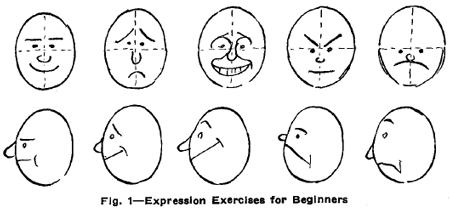
It should be understood that it is practically impossible to represent all the emotions with lifeless material. Many of the faces herewith shown might be unintelligible were it not for the text that accompanies them. How seldom it is that one can read the thoughts of even a real human being by means of the expression on his face merely. Nevertheless, some people can scarcely conceal their thoughts, although they speak not a word.
A man there was whose emotions were usually shown in his face. A bright young lady said to him : "You shouldn't think so people can see you. What a splendid model he would have made !
The actor can make quick facial changes indicating the emotions he imitates, whereas the artist is limited to immovable lines. The artist must take one expression or, perhaps, merely a phase of the expression, and then attempt to represent the emotion he desires to portray, fixing it immovably. unchanging. He can portray but one movement of many that in life go to tell the story 3. emotion without words.
Emotional Pictures
—In all ages workers with the brush and canvas, mallet and marble, have been practically unanimous in accepting certain representations of form to parallel, as well as they may, muscular and color changes caused by mental emotion—the telegraphic signals of the brain in action. Take, for instance, the facial diagram that portrays joy. In this the emotion is mostly expressed by the partly closed, but vivid eye, the mouth, with lips slightly apart, and the corners of the mouth slightly elevated.
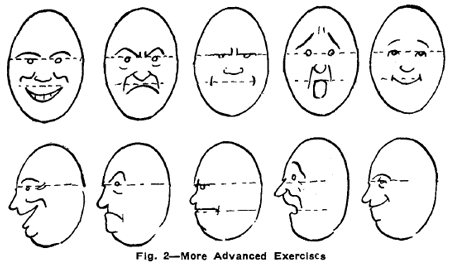
The figures depicting sorrow show the muscles of the face relaxed. In application the head should be inclined forward, the inner ends of the eyebrows are raised toward the forehead, the eyelids droop, while the pupil of the eye is raised. The lips are parted, somewhat as in joy, but the corners of the mouth are lowered. The general tendency of this emotion, because of the laxity of the muscles, is to lengthen the face. When sorrow, pity, pain, dejection, or melancholy, hold sway, man's face is proverbially long.
Pain, anguish and despair can hardly be separated from the general term of sorrow ; to an extent they are analogous, synonymous.
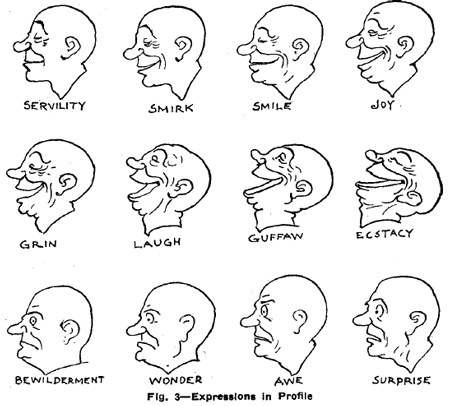
Next, take the figures denoting anger. The eyes blaze (usually shown in a black-and-white drawing by a very dark iris and strong high lights), the eyebrows are contracted, with the inner ends downward, and the outer ends inclining upward. The lips are compressed at the center, with a tendency to parting at the outer ends of the mouth. Approximately, the same lines are used to express revenge, hatred, rage and fury; different degrees of intensity and rigidity of lines being used to suit the ideas of the individual.
The study of expression is so full of interest that the pupil is easily encouraged to go to nature in order to gather more than a slight smattering of knowledge on this subject.
The effect and force of nearly every drawing in which the human face appears depends very largely on the extent to which the artist knows how to give expression to the human features. The beholder of the picture can be guided only by the artist's interpretation ; if it is false, the picture is misleading, therefore valueless.
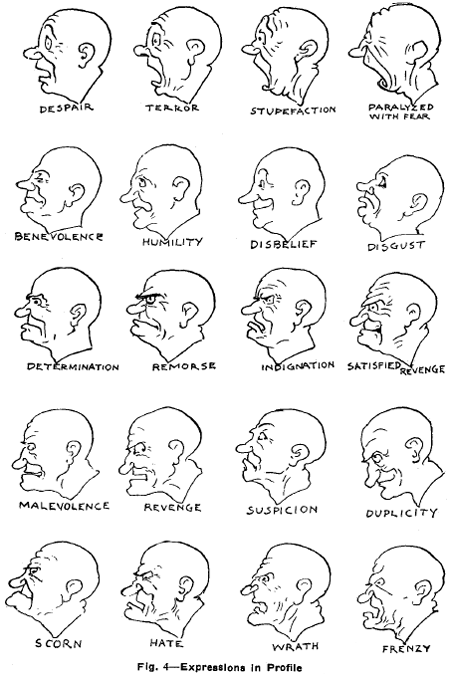
The definitions that accompany these diagram-like outlines of the various emotions are conventional. They are not absolute, and are even interchangeable to some degree. They are offered as hints and suggestions to aid individual observation. For the real thing in the way of emotion no better aid can he had than a mirror. Let the pupil survey himself in that and sketch the changes in his own features. Let him make faces at himself and then sketch them. He should try to keep the varying expressions in mind long enough to transfer to paper the principal lines by which they are formed.
Expression in the human face must be felt. It is difficult to teach it. There are so many minor points which go to make up the varied expressions that can be assumed by human features that detailed instruction is almost impossible.
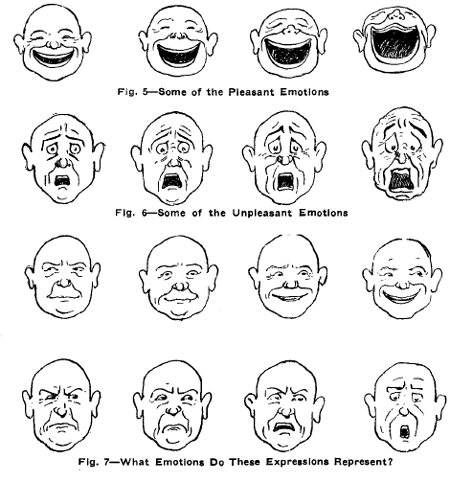
Animation may be expressed by dark touches in the eyes and under the lids. The nose also has much to do with expression; especially the shape of the nostrils and the direction of the lines of the sides of the nose running down to the mouth. Nostrils that droop downward at the outer edge give a serious expression ; on the .contrary, if the line is elevated, the tendency is towards a bright and animated expression.
The mouth, of course, is of great importance, and influences the expression more than any other feature. When smiling, the corners are turned upward and the lines or dimples are curved in an outward direction. In a sad face, the corners of the mouth drop downward and the lines grow straight.
The student of expression must look for indications in many faces, for there he will find more suggestions of importance than in all the pages of written instruction. Without such knowledge, he may work on blindly, puzzling himself to find out where he is wrong, and why the expression is just the opposite of what it should be.
Expression Exercises for Beginners
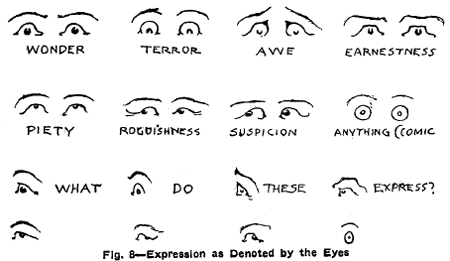
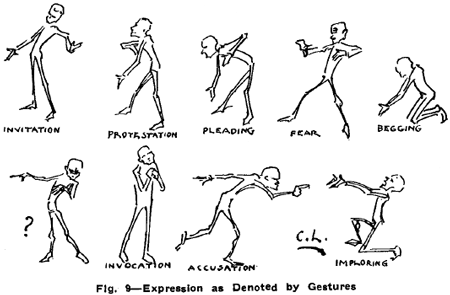
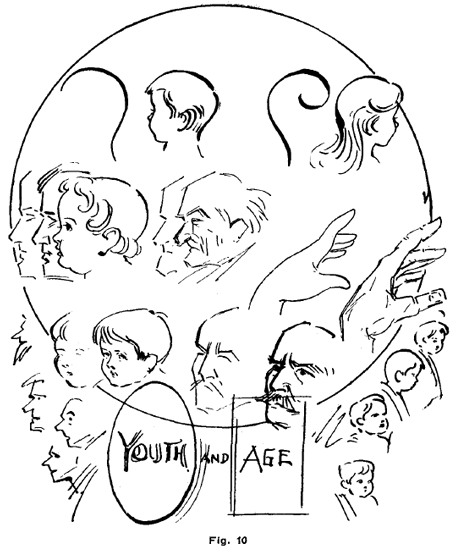
Youth and Old. Age.—Curved, graceful lines convey the impression of youth, while straight, angular lines are those mostly used to express age in various stages of advancement. In vegetable life, as may be noted (Fig. 11), the young have graceful lines, while in their old age angularity of lines is apparent.
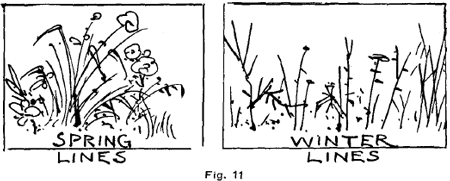
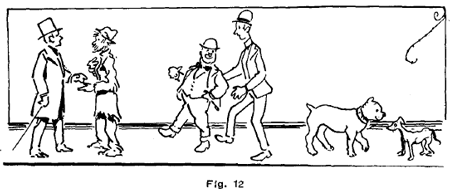
Contrasts of some sort are generally considered necessary to every drawing. Contrasts are not invariably caused by strength of line or tone or areas of black against white ; but they are frequently matters of character and costume. Thus, a tramp talking to a finely dressed man appears more tattered • than if he were addressing a commonly clad person, or if he were in a group made up of his own class. A short, fat man seems more obese if his companion in the picturejs long and lean.
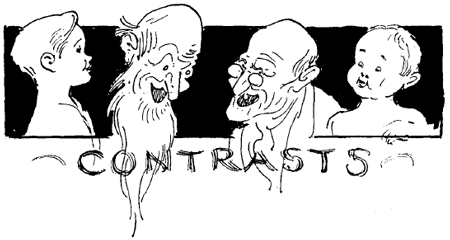
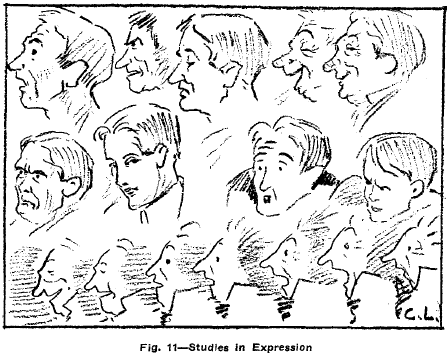
Privacy Policy .... Contact Us




